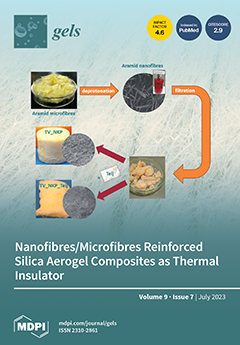In this study, we tested the biosorption capacity of trimethyl chitosan (TMC)-ZnO nanocomposite (NC) for the adsorptive removal of
Escherichia coli (
E. coli) in aqueous suspension. For the formation of ZnO NPs, we followed the green synthesis route involving
Terminalia mantaly
[...] Read more.
In this study, we tested the biosorption capacity of trimethyl chitosan (TMC)-ZnO nanocomposite (NC) for the adsorptive removal of
Escherichia coli (
E. coli) in aqueous suspension. For the formation of ZnO NPs, we followed the green synthesis route involving
Terminalia mantaly (TM) aqueous leaf extract as a reducing agent, and the formed ZnO particles were surface-coated with TMC biopolymer. On testing of the physicochemical characteristics, the TM@ZnO/TMC (NC) hydrogel showed a random spherical morphology with an average size of 31.8 ± 2.6 nm and a crystal size of 28.0 ± 7.7 nm. The zeta potential of the composite was measured to be 23.5 mV with a BET surface area of 3.01 m
2 g
−1. The spectral profiles of TM@ZnO/TMC NC hydrogel on interaction with
Escherichia coli (
E. coli) revealed some conformational changes to the functional groups assigned to the stretching vibrations of N-H, C-O-C, C-O ring, and C=O bonds. The adsorption kinetics of TM@ZnO/TMC NC hydrogel revealed the pseudo-second-order as the best fit mechanism for the
E. coli biosorption. The surface homogeneity and monolayer adsorption of the TM@ZnO/TMC NC hydrogel reflects majorly the entire adsorption mechanism, observed to display the highest correlation for Jovanovic, Redlich–Peterson, and Langmuir’s isotherm models. Further, with the use of TM@ZnO/TMC NC hydrogel, we measured the highest adsorption capacity of
E. coli to be 4.90 × 10 mg g
−1, where an in-depth mechanistic pathway was proposed by making use of the FTIR analysis.
Full article






